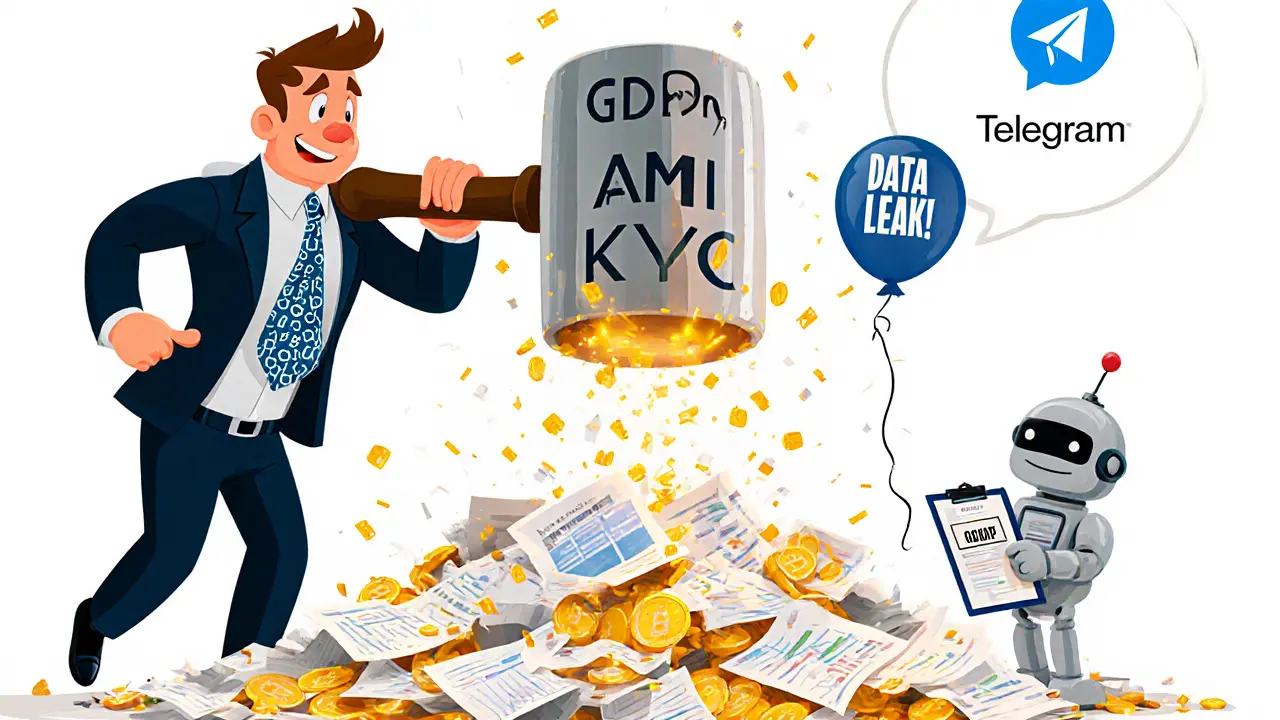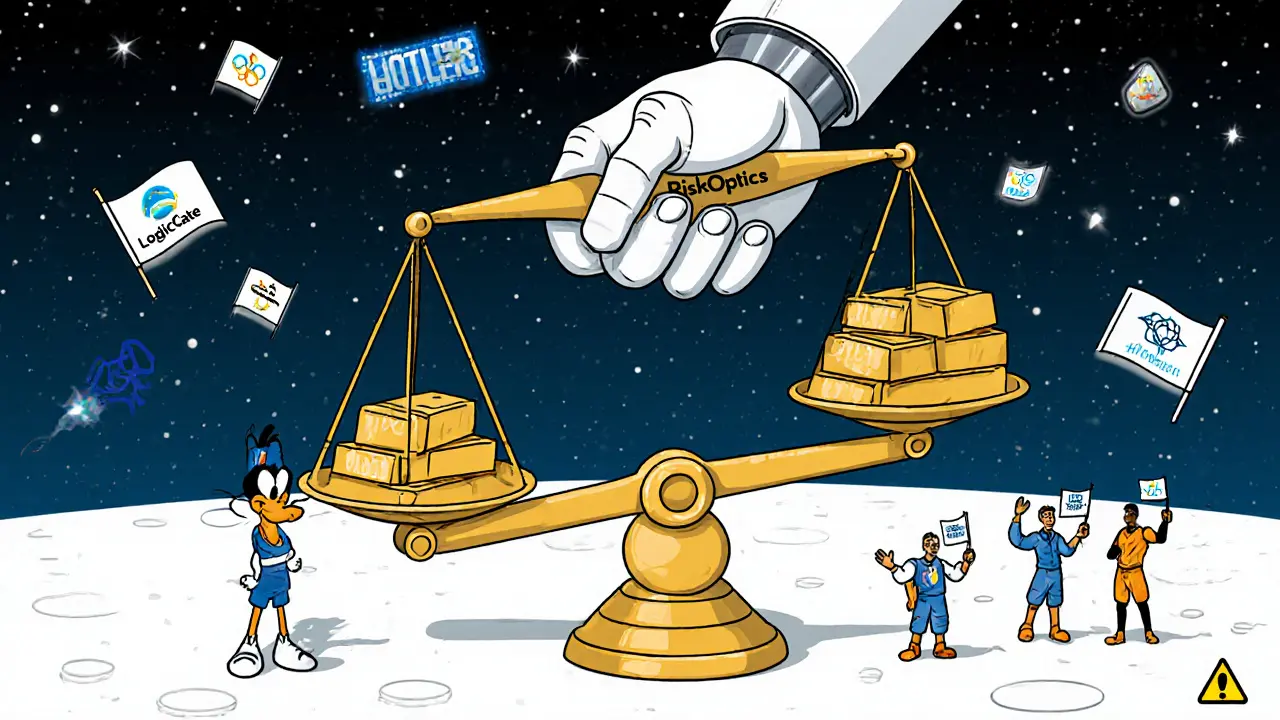Managing risk in blockchain projects isn’t optional-it’s survival. Whether you’re launching a DeFi protocol, running a crypto exchange, or building a smart contract platform, one wrong move can cost millions. And unlike traditional finance, blockchain moves fast, is global, and has no safety nets. That’s why modern risk management tools and calculators aren’t just helpful-they’re essential.
Why Blockchain Needs Specialized Risk Tools
Blockchain systems operate in a world where code is law, bugs are exploits, and regulations lag behind innovation. A single vulnerability in a smart contract can lead to a $100 million hack. A misconfigured wallet system can trigger regulatory fines. A poorly managed third-party vendor can expose your entire network. Traditional risk spreadsheets won’t cut it. You need tools that understand blockchain-specific threats: smart contract exploits, oracle manipulation, MEV attacks, liquidity pool drains, and regulatory gray zones across jurisdictions. The best platforms today don’t just list risks-they calculate them in dollars, predict their likelihood, and tie them directly to your business goals.LogicGate Risk Cloud: Financial Risk Quantification for Crypto Teams
LogicGate Risk Cloud stands out because it speaks the language of executives: money. Its Risk Cloud Quantify® feature uses Monte Carlo simulations and the Open FAIR™ framework to turn abstract cybersecurity risks into dollar values. For a DeFi startup, this means answering questions like: “If our liquidity pool gets drained, how much revenue do we lose? What’s the chance of that happening this quarter?” It’s no-code, so your compliance officer-not your dev team-can build custom workflows. You can link risks to specific smart contracts, wallet addresses, or API endpoints. The platform’s connected graph database shows how a vulnerability in your staking contract affects your KYC process, your insurance coverage, and your investor confidence-all in one view. But it’s not perfect. Some users report confusing label settings in risk scoring, and advanced reporting requires exporting data to tools like Tableau. Still, for teams that need to justify risk spend to investors or auditors, LogicGate is one of the few platforms that makes risk tangible.Sprinto: Compliance Automation Built for Crypto Startups
If you’re raising funds or applying for a crypto license, Sprinto is your secret weapon. It’s designed for compliance-heavy environments, which means it’s perfect for blockchain firms dealing with AML, KYC, GDPR, or MiCA regulations. Sprinto automatically maps your risks to compliance controls. For example, if you’re using a third-party oracle service, Sprinto flags it as a high-risk dependency and links it to your required audit trails and SLAs. It then pushes automated reminders to fix gaps before regulators come knocking. Its AI recommendations are sharp. If you’ve never done a vendor risk assessment, Sprinto walks you through it. If your team uses Telegram for sensitive discussions, it alerts you to data leakage risks. And unlike older tools, it doesn’t bury you in reports-it gives you a live 360-degree dashboard showing your real-time security posture. Smaller teams might find it overwhelming. But if you’re scaling fast and need to prove you’re compliant, Sprinto cuts months off your audit prep time.
OneTrust: Privacy and Risk in One Platform
OneTrust isn’t just for big tech. Crypto companies handling user data-wallet addresses, transaction histories, IP logs-need it too. With global privacy laws tightening, OneTrust helps you manage consent, data access requests, and cross-border transfers under GDPR, CCPA, and other frameworks. Its risk module ties data privacy gaps to financial exposure. For instance, if your app stores unencrypted wallet recovery phrases, OneTrust calculates the potential fine (up to 4% of global revenue under GDPR) and the likelihood of a breach based on industry trends. It also monitors third-party vendors-critical when you’re using cloud providers, analytics tools, or KYC services. The platform works on iOS, Android, and web, so your team can check risk status from anywhere. The 14-day free trial lets you test it without commitment. But setup is complex. You’ll need time to configure data maps and policy templates. If you’re not already deep in compliance, start with Sprinto instead.Traditional Tools: Calibrer RM and DevSpec for Dev Teams
If your team builds smart contracts or dApps, you likely already use Jira or Azure DevOps. Calibrer RM and DevSpec plug into those systems to manage risk alongside code requirements. They let you tag a smart contract function with a risk level: “High-reentrancy vulnerability.” Then you link it to a mitigation plan: “Use OpenZeppelin’s ReentrancyGuard.” You can generate risk matrices showing which parts of your code are most exposed. These tools are great for developers who want to bake risk into their sprint cycles. But they lack AI, real-time monitoring, and financial modeling. They’re not for executives-they’re for engineers. Use them if you’re building, not scaling.
RiskOptics: Strategic Risk for Enterprise Blockchain
RiskOptics is for organizations that treat risk like a strategic function-not a checkbox. It’s used by large exchanges, institutional custodians, and blockchain infrastructure providers. It lets you model operational risks across your entire stack: custody solutions, node operators, settlement systems, and even team turnover. You can simulate scenarios like “What if our primary node provider goes offline for 72 hours?” and see the financial and reputational impact. The downside? No free trial. No transparent pricing. You need to talk to a sales rep just to get a quote. If you’re a startup, this isn’t for you. But if you’re managing billions in assets and need board-level risk reporting, RiskOptics gives you the depth you can’t get elsewhere.Choosing the Right Tool for Your Blockchain Project
Here’s how to pick:- Early-stage startup? Start with Sprinto. It’s affordable, automated, and built for compliance-heavy industries.
- Need to explain risk to investors? Use LogicGate. Its dollar-based risk scores make the case for security spending.
- Handling user data across borders? OneTrust is your privacy backbone.
- Building smart contracts? Use DevSpec or Calibrer RM to tie risks directly to your codebase.
- Managing enterprise-scale assets? RiskOptics gives you the strategic depth you need.
What’s Next for Risk Management in Blockchain?
The next wave is AI-driven prediction. Platforms are starting to use machine learning to detect patterns in blockchain transactions that signal fraud before it happens. Some are integrating natural language processing to scan Discord, Telegram, and GitHub for early signs of exploits or rug pulls. Real-time risk dashboards are becoming standard. Soon, you’ll get alerts not just when a vulnerability is found-but when a hacker is actively probing your contract. Cloud-native, no-code platforms will dominate. Why? Because blockchain moves faster than IT departments. If your risk tool requires a developer to change a setting, you’re already behind. The future belongs to tools that don’t just track risk-they prevent it.What’s the best free risk management tool for blockchain projects?
OneTrust offers a 14-day free trial with core risk and privacy features, making it the best option to test-drive a professional platform. Most other tools like LogicGate and RiskOptics don’t offer free versions. For lightweight use, open-source tools like OWASP ZAP can scan smart contracts for vulnerabilities, but they don’t provide risk quantification or compliance mapping.
Can I use Excel for blockchain risk management?
You can, but you shouldn’t. Excel can’t link risks to live blockchain data, update in real time, or calculate financial impact using industry-standard models like Open FAIR. A spreadsheet might work for a side project, but if you’re handling real funds or user data, you’ll miss critical threats and fail audits. Modern tools automate what Excel can’t: continuous monitoring, vendor risk tracking, and compliance mapping.
How do risk calculators quantify blockchain risks?
Top tools like LogicGate and OneTrust use frameworks like Open FAIR, which breaks risk into two components: likelihood (how often a threat occurs) and financial impact (how much it costs). They plug in real-world data-like historical hack amounts, average downtime costs, and regulatory fine ranges-to generate dollar estimates. For example, a smart contract bug with a 15% chance of exploitation and a $2M potential loss equals a $300K expected loss. This turns abstract threats into business decisions.
Do these tools integrate with smart contract development platforms?
Yes, but only certain ones. DevSpec and Calibrer RM integrate directly with Jira, Azure DevOps, and GitLab to embed risk tracking into your development workflow. LogicGate and Sprinto offer API access to connect with blockchain analytics tools like Chainalysis or Nansen. If your team uses Solidity and Hardhat, look for platforms that support webhook integrations or custom risk tags in your CI/CD pipeline.
How long does it take to implement a risk management tool for a crypto startup?
Sprinto and OneTrust can be up and running in 3-6 weeks with basic setup. LogicGate, being no-code, often takes 2-4 weeks for core workflows. Traditional tools like DevSpec or Calibrer RM may take 6-12 weeks because they require integration with existing project systems. The key is starting with your biggest risk-like third-party vendors or smart contract audits-and building from there. Don’t try to do everything at once.
Are these tools only for large companies?
No. Sprinto and OneTrust have pricing tiers for small teams. Even LogicGate offers flexible licensing based on how many users need access-not on company size. Many blockchain startups begin with one tool (like Sprinto for compliance) and add others as they grow. The real barrier isn’t cost-it’s awareness. Most small teams don’t realize how much risk they’re exposed to until it’s too late.

LogicGate? Please. All these tools are just fancy Excel sheets with a blockchain sticker on them. You think a Monte Carlo simulation can predict a rug pull? LOL.
I just spent 3 weeks trying to get Sprinto to stop yelling at me for using Telegram and now I’m emotionally attached to it 😭 I mean, it flagged my cousin’s Discord server as a ‘high-risk communication channel’ and I didn’t even know he was in a crypto group!! But honestly?? It saved my neck when the SEC came knocking. I’m crying happy tears. 🤖💔
I’ve used all of these. Sprinto is the only one that didn’t make me want to quit crypto. The AI recommendations are shockingly accurate - especially about third-party vendors. If you’re a startup, just start with Sprinto and upgrade later. No need to overcomplicate it.
Bro LogicGate is good but u need to know FAIR framework or its just noise. I tried it with my team in Bangalore and we got lost in labels. Also, why no Hindi support? We are global now 😅
OneTrust? More like OnePAIN. You think they care about your privacy? They sell your data to the same banks that froze your crypto account last year. This isn’t risk management - it’s corporate surveillance with a nice UI. And don’t even get me started on the 14-day trial. They’ll track your every keystroke and sell it to the highest bidder. 😈
There’s a philosophical layer here that’s being ignored. Risk isn’t just a number - it’s a reflection of trust in systems designed to be trustless. When we quantify a smart contract exploit in dollars, we’re not measuring danger - we’re measuring our collective surrender to capital logic. The real tool isn’t software. It’s skepticism.
I appreciate the thorough breakdown. As someone mentoring early-stage founders, I can’t stress enough: don’t wait until you’re audited to implement risk tools. Start with Sprinto. It’s not glamorous, but it’s the digital equivalent of wearing a seatbelt. You won’t thank yourself until you’re in a crash - and by then, it’s too late.
You all are missing the point. These tools are designed to make you feel safe so you’ll keep investing in this dumpster fire. Blockchain is a Ponzi scheme wrapped in code. No tool can fix that. You’re just rearranging deck chairs on the Titanic with better UI.
I mean… Excel? Of course it’s not enough. But have you seen the cost of these platforms? $20K/year for LogicGate? That’s more than my entire dev team’s salary. And you’re telling me a startup should spend 80% of its budget on software that might not even catch a reentrancy attack? I’m not saying skip risk - I’m saying don’t let marketing sell you a solution to a problem you don’t fully understand yet
I tried Calibrer RM last month. It’s like GitHub for risk. Tag a function, link a fix, done. No fluff. My team loves it. But yeah - it’s not for execs. If you need to show ROI to investors, go with LogicGate. If you’re just trying not to get hacked, stick with the dev tools.
Sprinto got me through my first audit. Zero drama. Just worked. I’m not a compliance nerd but even I could use it. Best $500 I ever spent.
You all are so naive. No tool can stop a 51% attack or a centralised exchange collapse. These are just band-aids. Real risk is trusting any blockchain project at all. You think a calculator can predict when a founder will disappear with your ETH? Wake up
I think everyone’s overcomplicating this. Start small. Pick one risk - maybe third-party vendors - and fix that first. Don’t buy ten tools. Just fix one thing. Then move on. Progress > perfection.
I used to think risk tools were for ‘serious’ projects. Then my friend’s DAO got drained because no one checked their multisig setup. Now I use DevSpec. It’s simple. It’s free. It doesn’t talk down to you. Just tag the risk. Fix it. Move on.
Honestly? The real tool is a good dev team that reads the docs. All these platforms are just glorified checklists. If your devs don’t know what a reentrancy attack is, no software will save you.
I used LogicGate for a quarter. The reports looked beautiful. My investors loved them. But internally? We were still getting hacked. The tool made us feel safe. That’s the real danger.
I’ve been in this space since 2017. Every tool you listed has failed someone. Every. Single. One. I’ve seen $300M vanish because someone trusted a ‘risk dashboard’. You don’t need software. You need to stop trusting strangers with your money.
These tools are all controlled by the same Wall Street firms that created the 2008 crash. They want you to think you’re safe so you keep investing. The real risk? Believing this system can be secured. It’s designed to fail. Always has been.
So you’re telling me I should pay $15K/year to get alerted that my wallet is exposed… after it’s already been drained? Brilliant. Next you’ll sell me a candle to protect against a wildfire.
All these tools are overpriced. OWASP ZAP + manual audits + a decent dev team = cheaper and more effective. You’re paying for branding, not security.
If you’re reading this and you’re just starting out - please don’t panic. You don’t need all these tools. Start with one. Learn one. Master one. Then grow. I’ve seen too many founders burn out trying to do everything at once. You’ve got this.
I’m not sure why anyone uses LogicGate. It’s just a corporate PowerPoint with a blockchain logo. I used to work at a firm that paid $50K for it. We still got hacked. The tool just gave us paperwork to feel better.
The notion that risk can be quantified in dollars is fundamentally flawed. Risk is a human phenomenon - not a financial one. Tools like RiskOptics are designed to satisfy boards, not protect users. If your team can’t make ethical decisions without a dashboard, you’re already doomed.
I’ve worked with startups across the US, India, and Europe. Sprinto is the only one that doesn’t assume you’re a white male engineer in Silicon Valley. The interface is clear. The guidance is practical. And it doesn’t judge you for not knowing what ‘Open FAIR’ means. That’s rare.
All these tools are useless if you’re not American. Try using Sprinto in Nigeria or Venezuela. The compliance rules assume you’re in the EU or US. Global crypto doesn’t care about your regulatory frameworks. This is colonial tech.